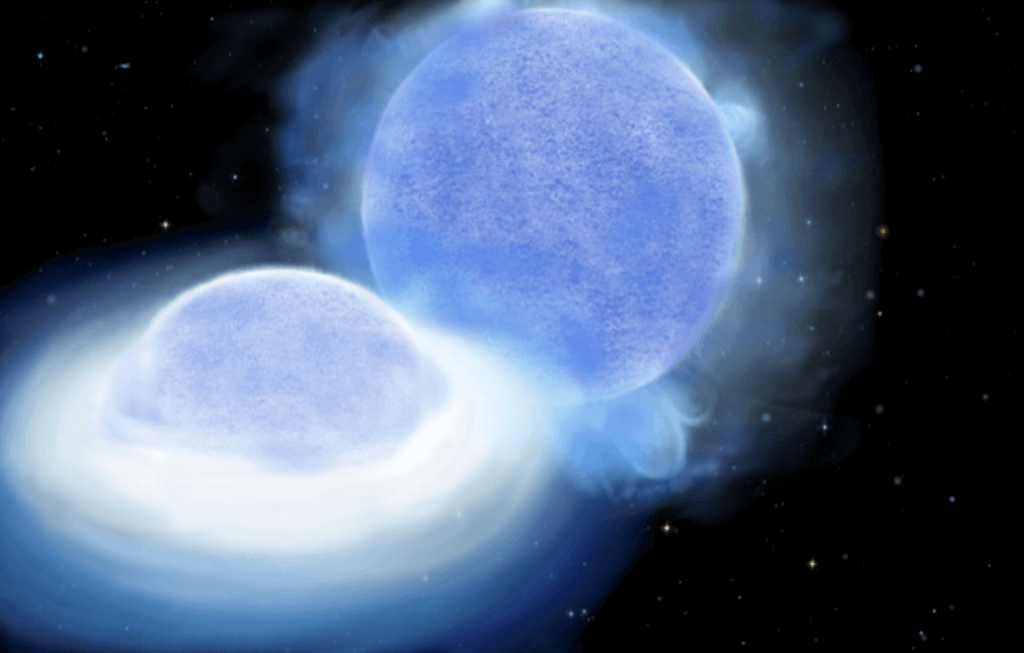Astronomers have discovered a population of stars that represent the “missing link” in the evolution of binary systems that eventually become colliding neutron stars.
These explosive merger events, called “kilonovas,” are believed to generate violent conditions that forge elements heavier than iron, including silver, gold, and platinum, that cannot be created at the heart of stars. Merging neutron stars are therefore vital to the dispersion of heavy elements throughout the universe.
The missing part of the evolutionary story of kilonovas comes in the form of stars in binary systems that have had their outer layers of hydrogen stripped away by a companion star. This leaves behind a star with exposed dense and hot outer layers of helium that have been forged deep with the star via the fusion of hydrogen.
Astronomers have known of low-mass stripped stars (subdwarfs) and high-mass stripped stars (Wolf-Rayet stars) of this type for some time, but these types are either too small or too large to result in systems that can develop into a kilonova. Intermediate-mass stripped helium stars with masses between two and eight times that of the sun , which are just right for such an event, have been elusive, however. The lack of detection of these missing-link stars has resulted in a so-called “helium star mass gap” that has had scientists questioning if models of the life cycle of massive stars could be wrong.
Related: A chaotic star is inching toward a violent death as astronomers watch in real time
In a new study, a team led by University of Toronto assistant professor Maria Drout detected 25 possible examples whose brightness and temperatures conformed with these missing stellar links.
“The stripped stars identified here are therefore valuable for constraining the physical properties of this important but elusive population,” the authors wrote in the study. “With estimated masses of around two to eight solar masses, they fill the helium-star mass gap, connecting subdwarfs with Wolf-Rayet stars and represent the first sample of the most likely progenitors for stripped-envelope core-collapse supernovae that can be studied in detail.”
The evolution of kilonovas
Intermediate-mass stripped helium stars begin life as giants with masses eight to 25 times that of the sun. They exist in a binary system with another star that is gradually pulling away their outer layers.
When the stripped star has run out of the fuel for nuclear fusion, it undergoes a type of cosmic explosion called an ultra-stripped supernova, which ejects little material but leaves behind a neutron star. At this point, the tables are turned, and that newly born neutron star begins to feed on its companion star, resulting in the companion also undergoing an ultra-stripped supernova explosion.
The result is a neutron star binary system comprised of two tightly bound dense stellar corpses that emit gravitational waves as they orbit each other. These gravitational waves, ripples in space-time first predicted by Albert Einstein in his 1915 theory of gravity, general relativity, continuously carry away angular momentum from the neutron star binary, causing the stellar remnants to spiral together faster and faster until they collide and merge in a kilonova.
Most of this process is in the distant future for the intermediate-mass stripped helium star systems found by Drout and her colleagues, however.
How astronomers found the missing link
The team suspects that the reason these missing stellar links may be difficult to observe is because the light they radiate in the optical spectrum is dominated by the emissions from their currently hydrogen-burning companion stars.
The researchers worked around this inconvenience by instead hunting for these stars in ultraviolet (UV) light, targeting two neighbors of our Milky Way galaxy, the dwarf galaxies the Large Magellanic Cloud and the Small Magellanic Cloud, in data collected by the Neil Gehrels Swift Observatory’s Magellanic Cloud Survey. This work revealed 25 sources predicted to eventually erupt in stripped-core supernovas, resulting in a neutron star binary that will spiral together and merge.
This detailed study of these mass gap stars may help solve a puzzle regarding an intermediate-mass stripped helium star found in June of this year by a team led by Heidelberg University researcher Varsha Ramachandran, in the form of a light supergiant star in the Small Magellanic Cloud.
“With our discovery, we demonstrate that the long-missing population of such stars is actually there!” Ramachandran said in a statement last month. “But our findings also indicate that they might look very different from what we had expected.”
The star Ramachandran and her team saw has not completely lost its outer layers, instead retaining a small but sufficient amount of hydrogen atop its helium core. If this is the case with other intermediate-mass stripped helium stars, that could make them appear much bigger and cooler than they really are. So it’s possible that these partially stripped stars have been hiding in plain sight all along.
The new study has been accepted for publication in the journal Science. A preprint version of the paper is currently available on the paper repository site arXiv.

